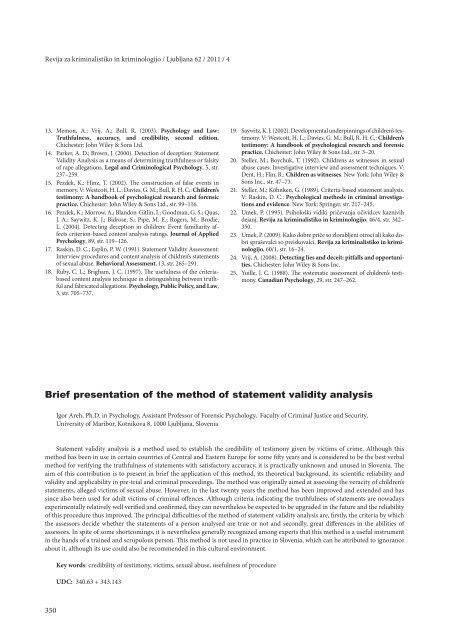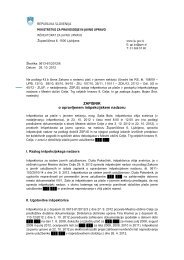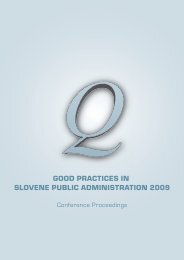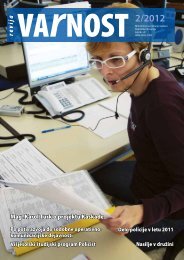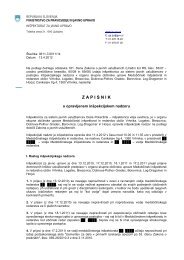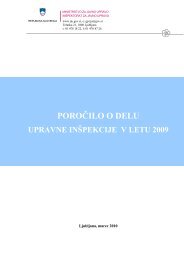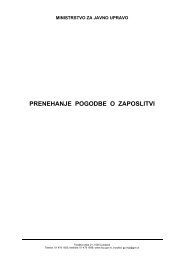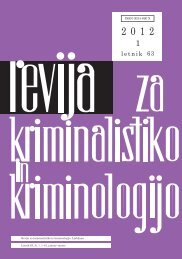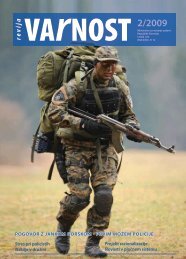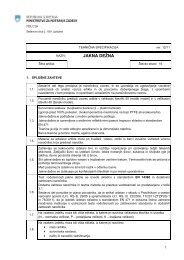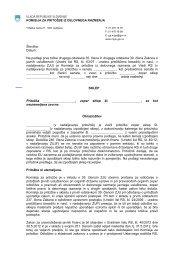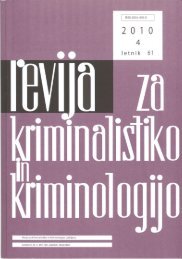Revija 4, 2011 - Ministrstvo za notranje zadeve
Revija 4, 2011 - Ministrstvo za notranje zadeve
Revija 4, 2011 - Ministrstvo za notranje zadeve
Create successful ePaper yourself
Turn your PDF publications into a flip-book with our unique Google optimized e-Paper software.
<strong>Revija</strong> <strong>za</strong> kriminalistiko in kriminologijo / Ljubljana 62 / <strong>2011</strong> / 4<br />
13. Memon, A.; Vrij, A.; Bull, R. (2003). Psychology and Law:<br />
Truthfulness, accuracy, and credibility, second edition.<br />
Chichester: John Wiley & Sons Ltd.<br />
14. Parker, A. D.; Brown, J. (2000). Detection of deception: Statement<br />
Validity Analysis as a means of determining truthfulness or falsity<br />
of rape allegations. Legal and Criminological Psychology, 5, str.<br />
237–259.<br />
15. Pezdek, K.; Hinz, T. (2002). The construction of false events in<br />
memory. V: Westcott, H. L.; Davies, G. M.; Bull, R. H. C.: Children’s<br />
testimony: A handbook of psychological research and forensic<br />
practice. Chichester: John Wiley & Sons Ltd., str. 99–116.<br />
16. Pezdek, K.; Morrow, A.; Blandon-Gitlin, I.; Goodman, G. S.; Quas,<br />
J. A.; Saywitz, K. J.; Bidrose, S.; Pipe, M. E.; Rogers, M.; Brodie,<br />
L. (2004). Detecting deception in children: Event familiarity affects<br />
criterion-based content analysis ratings. Journal of Applied<br />
Psychology, 89, str. 119–126.<br />
17. Raskin, D. C.; Esplin, P. W. (1991). Statement Validity Assessment:<br />
Interview procedures and content analysis of children’s statements<br />
of sexual abuse. Behavioral Assessment, 13, str. 265–291.<br />
18. Ruby, C. L.; Brigham, J. C. (1997). The usefulness of the criteriabased<br />
content analysis technique in distinguishing between truthful<br />
and fabricated allegations. Psychology, Public Policy, and Law,<br />
3, str. 705–737.<br />
350<br />
19. Saywitz, K. J. (2002). Developmental underpinnings of children’s testimony.<br />
V: Westcott, H. L.; Davies, G. M.; Bull, R. H. C.: Children’s<br />
testimony: A handbook of psychological research and forensic<br />
practice. Chichester: John Wiley & Sons Ltd., str. 3–20.<br />
20. Steller, M.; Boychuk, T. (1992). Childrens as witnesses in sexual<br />
abuse cases: Investigative interview and assessment techniques. V:<br />
Dent, H.; Flin, R.: Children as witnesses. New York: John Wiley &<br />
Sons Inc., str. 47–73.<br />
21. Steller, M.; Köhnken, G. (1989). Criteria-based statement analysis.<br />
V: Raskin, D. C.: Psychological methods in criminal investigations<br />
and evidence. New York: Springer, str. 217–245.<br />
22. Umek, P. (1995). Psihološki vidiki pričevanja očividcev kaznivih<br />
dejanj. <strong>Revija</strong> <strong>za</strong> kriminalistiko in kriminologijo, 46/4, str. 342–<br />
350.<br />
23. Umek, P. (2009). Kako dobre priče so zlorabljeni otroci ali kako dobri<br />
spraševalci so preiskovalci. <strong>Revija</strong> <strong>za</strong> kriminalistiko in kriminologijo,<br />
60/1, str. 16–24.<br />
24. Vrij, A. (2008). Detecting lies and deceit: pitfalls and opportunities.<br />
Chichester: John Wiley & Sons Inc.<br />
25. Yuille, J. C. (1988). The systematic assessment of children’s testimony.<br />
Canadian Psychology, 29, str. 247–262.<br />
Brief presentation of the method of statement validity analysis<br />
Igor Areh, Ph.D. in Psychology, Assistant Professor of Forensic Psychology, Faculty of Criminal Justice and Security,<br />
University of Maribor, Kotnikova 8, 1000 Ljubljana, Slovenia<br />
Statement validity analysis is a method used to establish the credibility of testimony given by victims of crime. Although this<br />
method has been in use in certain countries of Central and Eastern Europe for some fifty years and is considered to be the best verbal<br />
method for verifying the truthfulness of statements with satisfactory accuracy, it is practically unknown and unused in Slovenia. The<br />
aim of this contribution is to present in brief the application of this method, its theoretical background, its scientific reliability and<br />
validity and applicability in pre-trial and criminal proceedings. The method was originally aimed at assessing the veracity of children’s<br />
statements, alleged victims of sexual abuse. However, in the last twenty years the method has been improved and extended and has<br />
since also been used for adult victims of criminal offences. Although criteria indicating the truthfulness of statements are nowadays<br />
experimentally relatively well verified and confirmed, they can nevertheless be expected to be upgraded in the future and the reliability<br />
of this procedure thus improved. The principal difficulties of the method of statement validity analysis are, firstly, the criteria by which<br />
the assessors decide whether the statements of a person analysed are true or not and secondly, great differences in the abilities of<br />
assessors. In spite of some shortcomings, it is nevertheless generally recognized among experts that this method is a useful instrument<br />
in the hands of a trained and scrupulous person. This method is not used in practice in Slovenia, which can be attributed to ignorance<br />
about it, although its use could also be recommended in this cultural environment.<br />
Key words: credibility of testimony, victims, sexual abuse, usefulness of procedure<br />
UDC: 340.63 + 343.143


